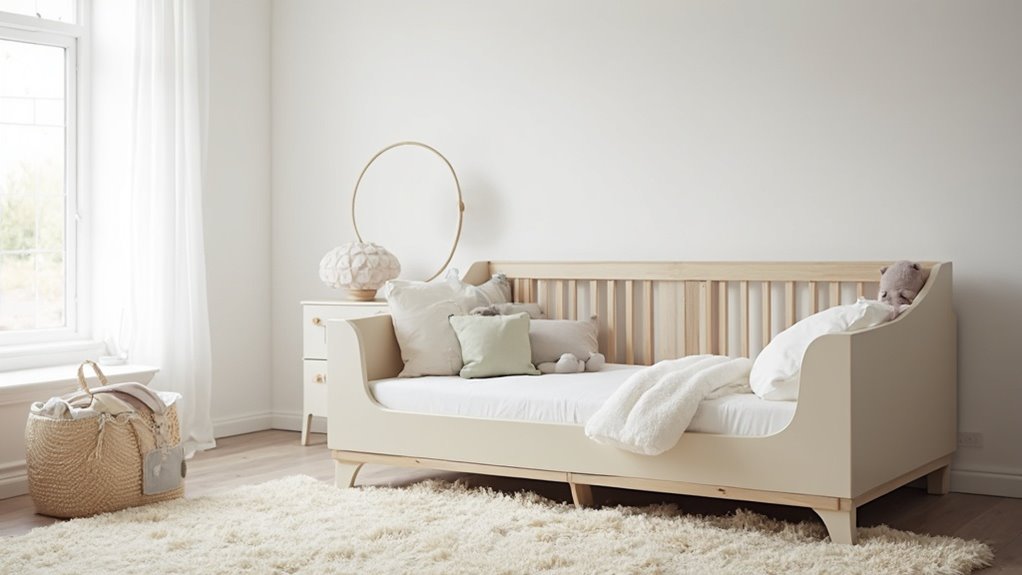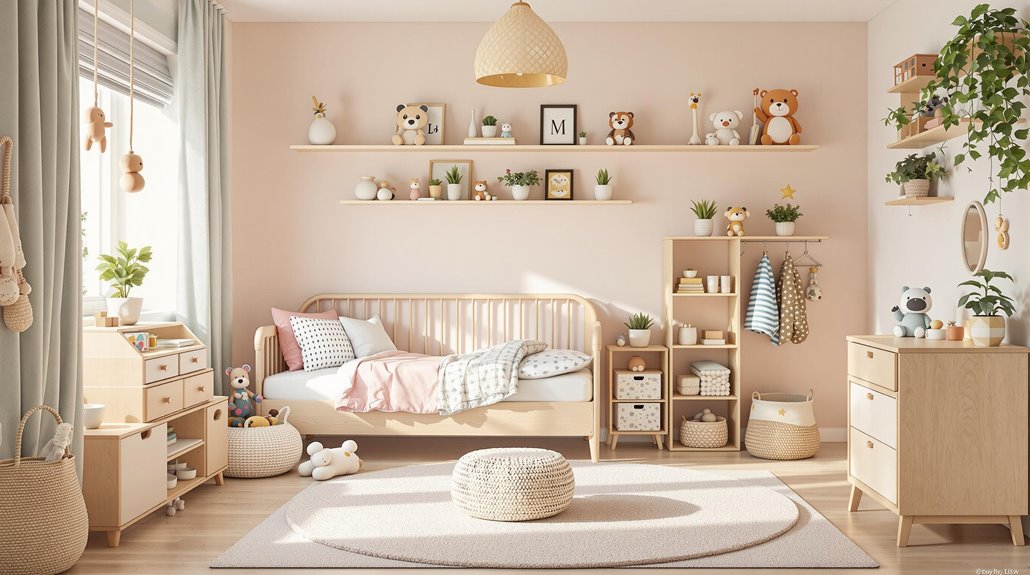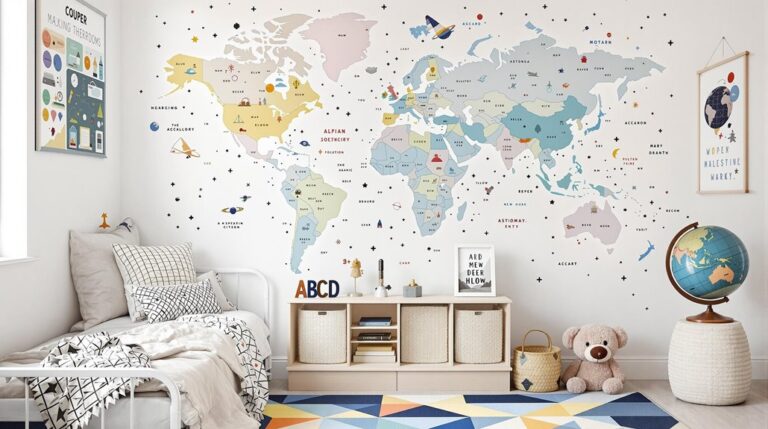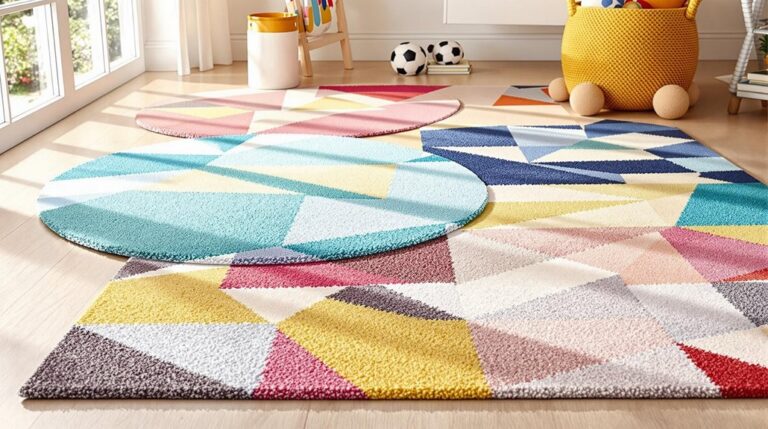Toddler bedroom furniture demands a delicate balance of safety, functionality, and whimsy. Look for tip-over-proof bookshelves, low-profile beds with rounded edges, and multi-purpose storage that encourages independence. Prioritize durable materials like solid wood and Baltic birch plywood, ensuring pieces can withstand energetic play while adapting to developmental stages. Incorporate child-height storage, interactive spaces, and personalized touches that spark imagination. From convertible beds to wall-mounted shelves, each piece should support physical exploration, cognitive growth, and creative expression. Want to transform a simple room into a nurturing developmental sanctuary that grows with your child? The magic lies in thoughtful design that prioritizes both safety and wonder.
Briefly keys
- Choose convertible beds with adjustable heights that can grow with your child and provide safe, low-to-floor configurations.
- Prioritize furniture made from durable, non-toxic materials like solid wood or Baltic birch plywood to ensure long-term safety and quality.
- Incorporate tip-over prevention strategies by securely anchoring furniture to walls and maintaining balanced weight distribution.
- Select multi-functional furniture with integrated storage solutions that encourage organization and support toddler independence.
- Design the bedroom with interactive, playful elements at child height, promoting creativity, engagement, and developmental stimulation.
Essential Safety Features

When designing a toddler's bedroom, safety must be the paramount consideration for furniture selection and placement. Every piece, including the bed to the bookshelf, requires meticulous evaluation to prevent potential hazards that could transform a child's sanctuary into a danger zone.
Tip-over prevention becomes critical when selecting furniture. Bookshelves, dressers, and cabinets must be securely anchored to walls using robust brackets and bolts, eliminating the risk of accidental toppling. Strategically distributing weight across shelves and avoiding top-heavy configurations further mitigates potential accidents. Proper furniture securing techniques can prevent devastating furniture-related injuries.
Consider furniture with rounded edges and sturdy construction to minimize injury risks.
Window safety demands equal attention. Position furniture away from windows to discourage climbing and potential falls. Install window guards or stoppers to restrict window openings, and secure blind cords to prevent strangulation hazards.
Window mesh provides an additional protective layer, ensuring curious toddlers cannot access dangerous areas.
Choosing furniture with non-toxic materials, ensuring snug-fitting mattresses, and utilizing guard rails on beds creates a thorough safety approach. By prioritizing these essential features, parents can craft a secure, nurturing environment where their little ones can explore and dream safely.
Smart Storage Solutions
Because efficient storage is essential in a toddler's bedroom, strategic organization can transform a chaotic space into a functional and orderly environment. Vertical organization becomes a game-changer, utilizing wall spaces with shelves, pegboards, and over-the-door organizers that maximize every inch of available room while keeping precious items safely out of tiny hands' reach. Shelves and pegboards provide an excellent method for displaying and organizing small items vertically, creating visual interest while maximizing limited space.
Multi-use furniture emerges as another brilliant solution, offering ingenious design that grows with your child. Beds with built-in drawers, loft configurations with hidden storage compartments, and desks featuring integrated shelving provide flexible spaces that adapt to changing needs. These clever pieces not only store belongings efficiently but also create dynamic, engaging environments that spark imagination.
Thoughtful storage strategies like labeled bins, clear containers, and child-height baskets encourage young ones to participate in maintaining order. By making organization accessible and fun, parents can transform tidying from a chore into an interactive experience.
Rotating toys and using transparent storage keeps spaces fresh and interesting, while teaching valuable organizational skills. The key is creating a system that feels intuitive, comfortable, and slightly magical—a space where storage becomes an adventure of discovery for curious toddlers.
Adaptable Bed Designs

Steering the evolving needs of toddlers, adaptable bed designs represent a strategic approach to children's bedroom layouts. These innovative furniture solutions prioritize toddler independence by offering low-to-floor configurations that empower young explorers to navigate their personal spaces safely and confidently.
Convertible bed options transform traditional furniture into multifunctional spaces, allowing parents to maximize utility without constant replacements. By seamlessly converting from a toddler bed into kid-sized chairs and a table, these designs adjust to changing developmental stages with remarkable versatility.
Height adjustability becomes a critical feature, enabling the bed to grow alongside the child. Parents can raise mattress platforms incrementally, supporting the child's progression from early childhood through teenage years. This thoughtful engineering guarantees that furniture remains relevant and supportive across multiple growth phases.
Safety remains paramount in these designs. With reinforced frames, wooden side rails, and certifications from ASTM and CPSC, these beds provide parents peace of mind. The Birch Montessori Floor Bed demonstrates exceptional adaptability, offering multiple size and configuration options to support children's developmental needs.
Free from harmful chemicals like phthalates and lead, they represent a contemporary approach to children's bedroom furniture—intelligent, flexible, and meticulously crafted to nurture a child's emerging sense of autonomy.
Materials That Last
Although toddlers' furniture demands exceptional durability, selecting the right materials represents a critical foundation for long-lasting bedroom design. Sustainable materials like solid wood and Baltic birch plywood offer both aesthetic charm and remarkable resilience, guaranteeing furniture can withstand the spirited adventures of growing children.
Solid wood options such as oak and maple provide classic durability, while plywood presents a cost-effective alternative that resists warping and maintains structural integrity. For eco-friendly considerations, materials like Baltic birch plywood stand out, featuring consistent layers and natural moisture resistance that enhance longevity.
Parents seeking versatile solutions might explore metal and plastic furniture, which offer lightweight design and easy maintenance. However, prioritizing non-toxic finishes remains paramount. Avoiding materials with harmful chemicals guarantees a safe environment where children can explore and play without parental anxiety.
When evaluating furniture materials, consider not just immediate functionality but long-term value. Durable, well-constructed pieces crafted from high-quality wood or metal can adapt through multiple developmental stages, becoming cherished pieces that grow alongside your child's evolving bedroom landscape. Safety standards dictate rigorous testing and quality control to ensure children's furniture meets the highest protection requirements.
Playful Room Styling

Transforming a toddler's bedroom into a lively, imaginative space requires strategic design that balances playful aesthetics with functional considerations. Parents can create enchanting environments by incorporating whimsical details like fabric art that simultaneously adds color and helps soundproof the room. Safety features are critical in designing a toddler's space, ensuring non-toxic materials and rounded furniture edges minimize potential injury risks.
Themed rooms offer tremendous potential for personalization, whether selecting a western adventure motif, outer space exploration, or fairy tale wonderland that resonates with a child's budding imagination.
Interactive spaces become essential in these design strategies. A curtained stage can inspire spontaneous performances, while low-level storage encourages independence and easy toy access. Positioning artwork and decorations at a toddler's eye level guarantees engagement and creates a sense of ownership in their personal sanctuary.
Practical yet playful elements like child-sized furniture, wall hooks for clothing, and cozy reading corners transform bedrooms from mere sleeping spaces into dynamic learning environments. A vintage chandelier or bold graphic wallpaper can introduce sophisticated touches that elevate the room's aesthetic, making it feel both whimsical and intentionally designed.
The key is crafting a space that stimulates creativity, supports developmental needs, and reflects the unique personality of its young inhabitant.
People are Asking
How Often Should I Replace My Toddler's Furniture as They Grow?
Replace toddler furniture based on growth milestones and furniture durability, typically every 3-5 years. Assess condition regularly, prioritizing safety, support, and functionality while your child develops and progresses through different stages.
Can I Mix Different Furniture Styles in My Toddler's Bedroom?
Mixing furniture styles in a toddler's bedroom is possible by maintaining a cohesive design theme, balancing different pieces, and using consistent color tones to create a harmonious and visually appealing space that grows with your child.
What Are the Signs That Furniture Is No Longer Safe for Use?
Signs of furniture becoming unsafe include significant wear and tear, structural damage, loose hardware, non-compliance with current safety standards, visible cracks, rust, wobbling, and compromised stability that could pose potential risks to users.
How Do I Involve My Toddler in Choosing Their Bedroom Furniture?
Playful Preferences: Prompt your toddler to select furniture colors and explore storage solutions by showing pictures, offering choices, and observing their excited reactions to different designs and textures.
Are Secondhand Toddler Furniture Pieces Safe to Use and Purchase?
Secondhand toddler furniture can be safe if carefully evaluated against current safety standards, inspected for damage, and cleaned thoroughly. Prioritize non-toxic furniture materials and verify the item's structural integrity before purchasing.
Wrapping up
Toddler bedroom furniture represents a nuanced intersection of safety, functionality, and developmental support. Consider a hypothetical scenario: A carefully designed bedroom becomes a child's first independent space, fostering autonomy and creativity. Strategic furniture selections transcend mere aesthetic choices, serving as instrumental tools in childhood development. Thorough planning guarantees environments that nurture growth, security, and imaginative exploration during critical developmental years.




